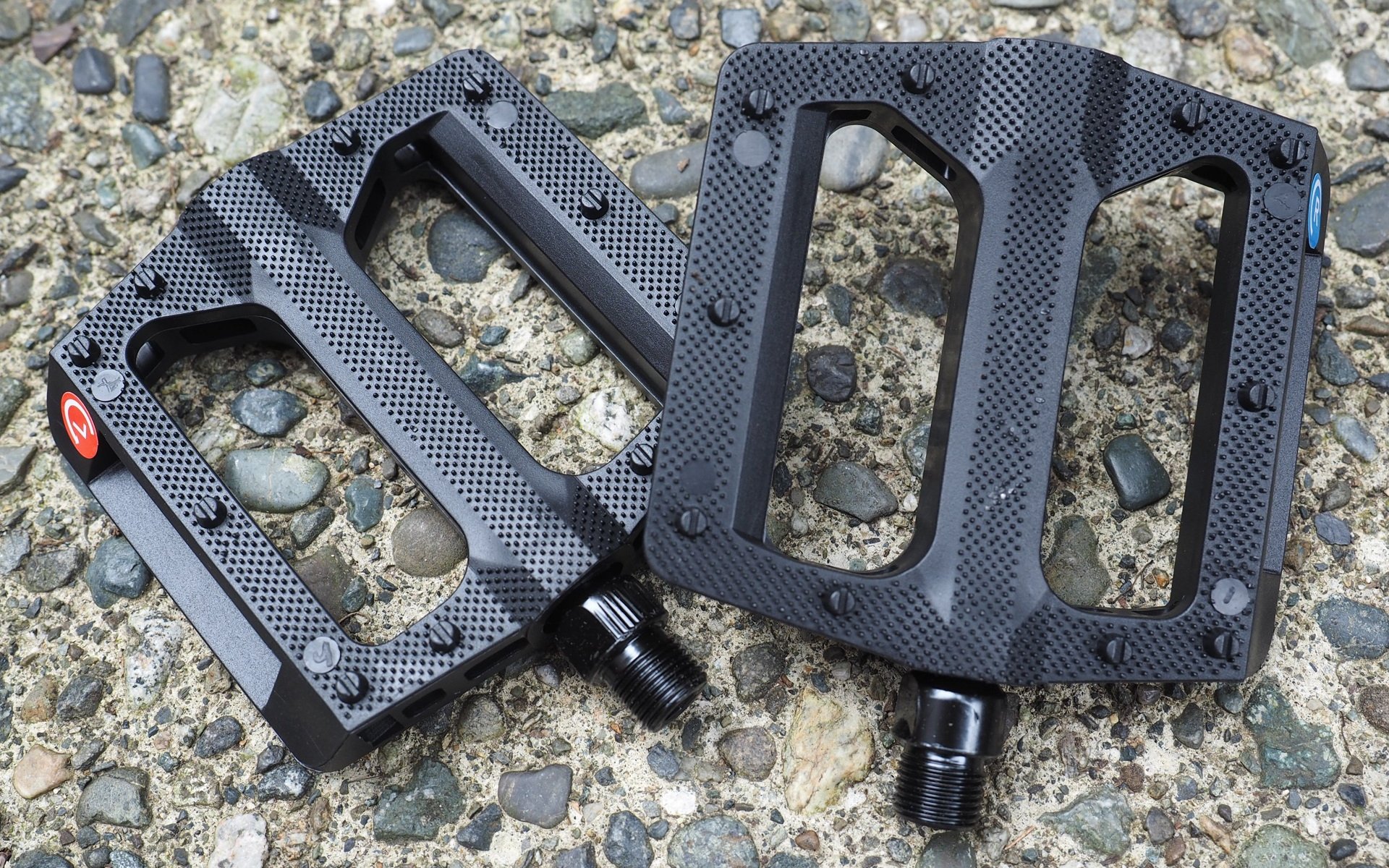
EDITORIAL
'Real' Mountain Bikes Don't Come With Pedals
Waste & Opportunity
If you haven't bought or built a budget hardtail lately, and weren't purchasing performance mountain bikes in the aughts, you're probably wondering what I'm on about now. Let's catch you up. For many years, you could walk into any bike shop on the North Shore and there would be a bucket of flat-and-narrow take-off handlebars. It took the bike industry a long time to figure out that cutting down too-wide bars is easy but making them wider is impossible. Wider bars, and upsizing bikes, also meant plenty of take-off stems. The true godsend of the 31.8mm handlebar standard replacing 25.4mm for mountain bikes and 26.0mm for road bikes is that at least those 100mm+ stems could be rehomed onto road bikes.
Even after stems and bars were largely sorted, every performance mountain bike was still coming with a pair of level-appropriate clip-in pedals. For a while you could pick up a pair of Shimano M520 clip-ins, in silver or black, for the price of a pair of cleats. It wasn't just folks switching to flat pedals that created the boxes of takeoffs either. Many riders used a different clip-in system, from a competing brand like Time or Crankbrothers, or were dedicated Shimanophiles that preferred a different pedal, the floating platform DX clipless being a very popular option.
Eventually, companies realized there was a near infinite number of choices in the world of pedals (still only a fraction of what's available now) and a variety of rider tastes to go with them. There were folks running Straitline pedals on mostly-Deore hardtails with patched up tires they found in a pile behind their local shop. There were folks running cheap loose-ball platforms with the pins molded in on their full XTR super sleds. Every ride group that used flats had that one person who could ride any skinny while clipped in. Every ride group that used clip-in pedals had that one person that could clean every technical climb on flats.
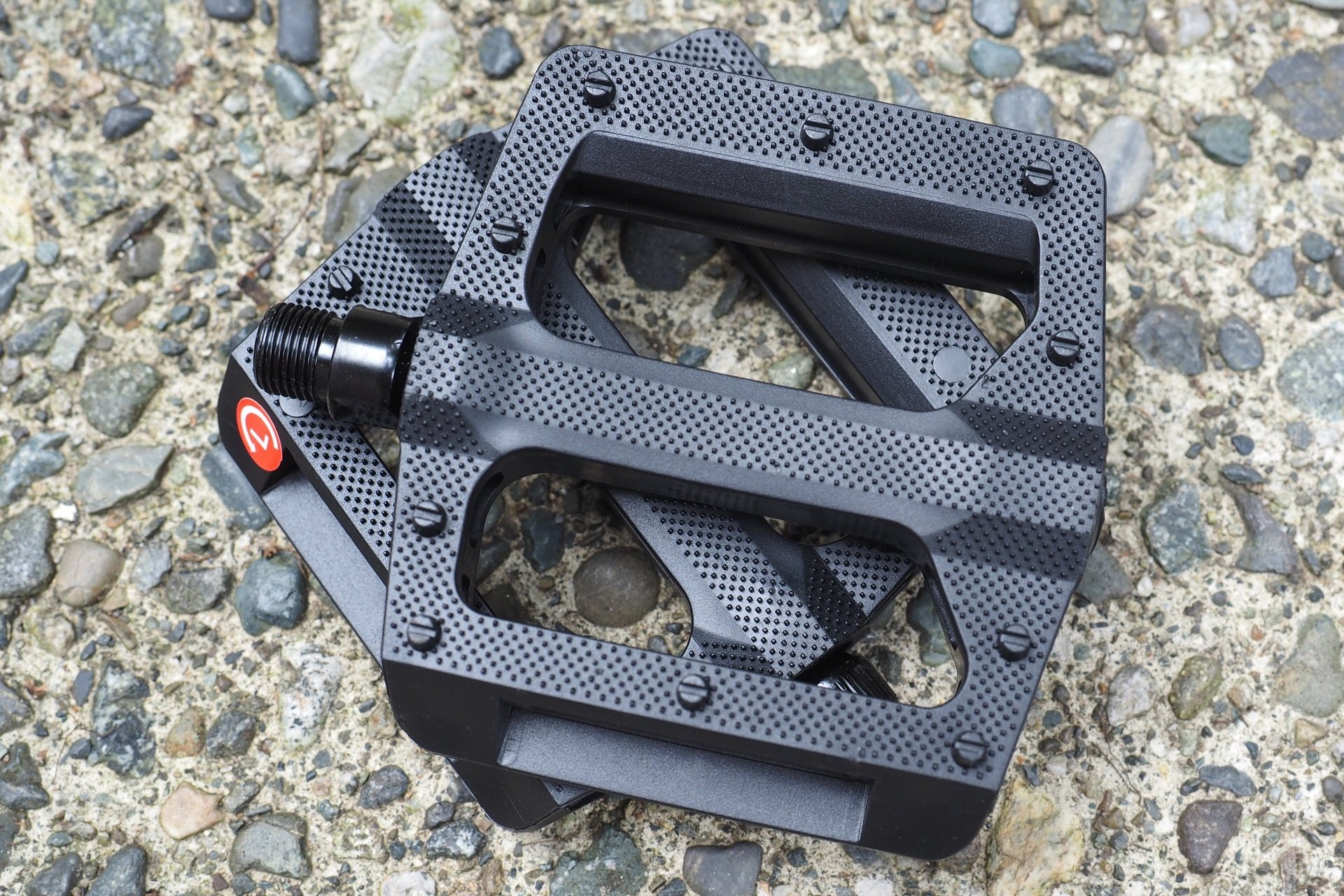
So we're clear, no manufacturer is including rideable pedals with these bikes. We're talking about in-moulded plastic traction 'pins' and loose ball bearings that barely spin.
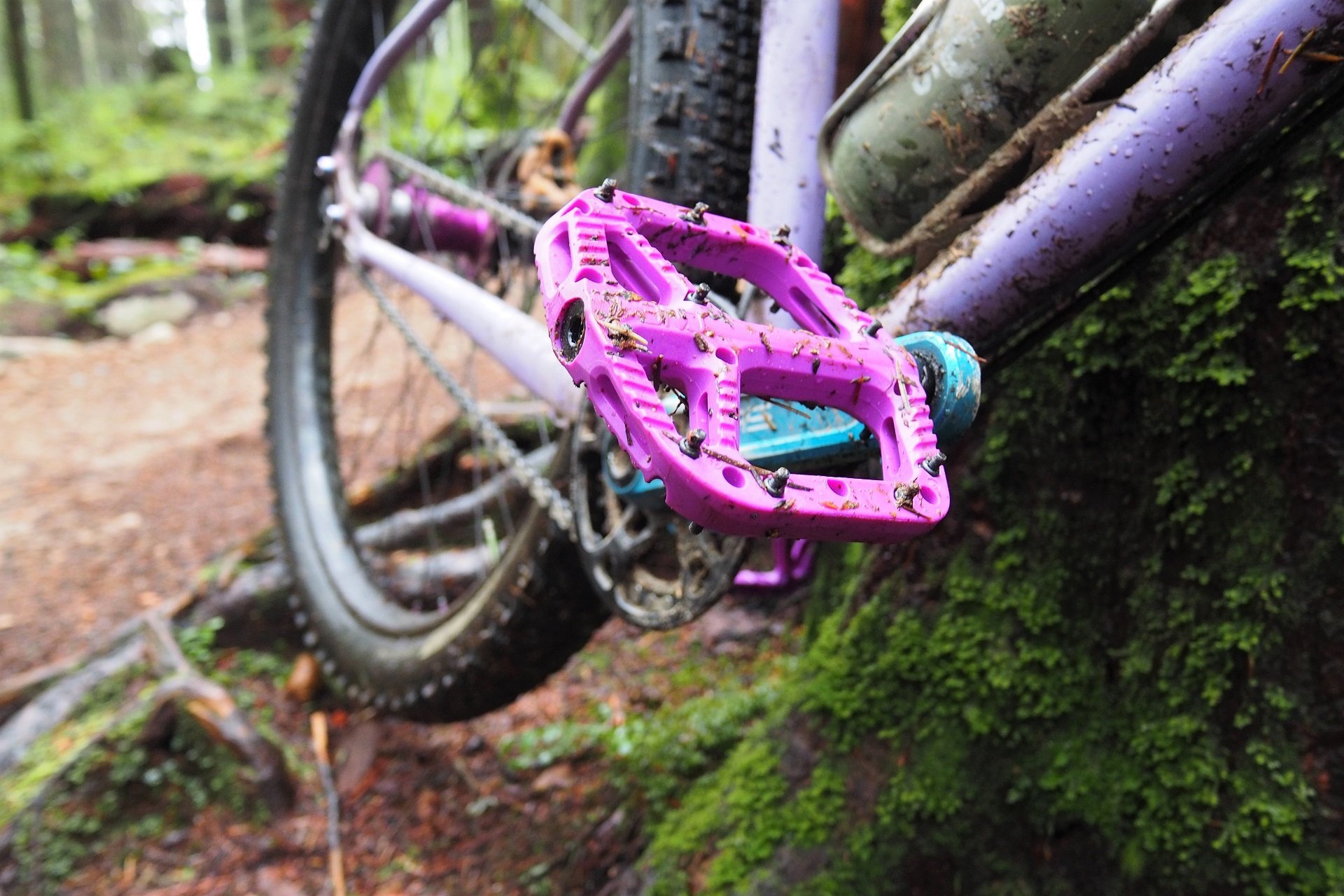
Big platforms, small platforms, convex, concave, or skipping flats and clipping in, there are endless options. I think the OneUp Composite is a great place to start.
From a product management perspective, these wasted pedal dollars were an opportunity to invest a few bucks elsewhere in the build. But, apparently due to demand from consumers and crappy bike shops, below a certain price point budget mountain bikes still include platforms for your feet. We're talking about the cheapest plastic flat pedals here. No manufacturer is including properly off-road-rideable flat pedals. Essentially wasting your money, yes - just a couple of bucks, by equipping an unrideable component destined for the recycling bin. No decent shop is sending you out on this crap as part of a test ride: contact points matter, a lot. Most shops don't have the real estate to have pedals on bikes on the floor anyways and when they're tightly packed no one wants the inventory attacking itself.
But, it's just a couple of bucks! Hardly worth ranting about? Except, every bike you've checked out with really sh*t stock grips, or a complete ass hatchet of a saddle, was a buck or two away from just needing a pair of pedals instead of pedals, saddle, and grips. And so the vast majority of companies stopped including any sort of pedal with their mountain bikes. That is their 'real' mountain bikes. The ones that are going to be ridden off-road. And I suppose, in my mind, for those companies that don't include any sort of pedal with their premium bikes (the price point where they stop throwing a set in the box, instead of investing that money elsewhere in the spec) are making a declaration about the line between a bicycle and a mountain bicycle.
This isn't meant to call out any specific brand. Most of them do it. My problem is that these same budget-friendly bikes that are coming with pedals are also the ones where every nickel and dime can make a difference. Is the rig getting a decent set of Tektro M275 hydraulic brakes or some sketchy garbage? Will I get a really decent clutched MicroShift drivetrain, or is it sloppy shifting and endless dropped chains? Rubber that I can at least run until my budget allows for a tackier front tire? These are tight decisions. No one riding one of these bikes on trails is going to use the pedals they come with, and anyone buying a bike that isn't going to be used on trails should probably be considering a bicycle with slick tires and fender mounts.
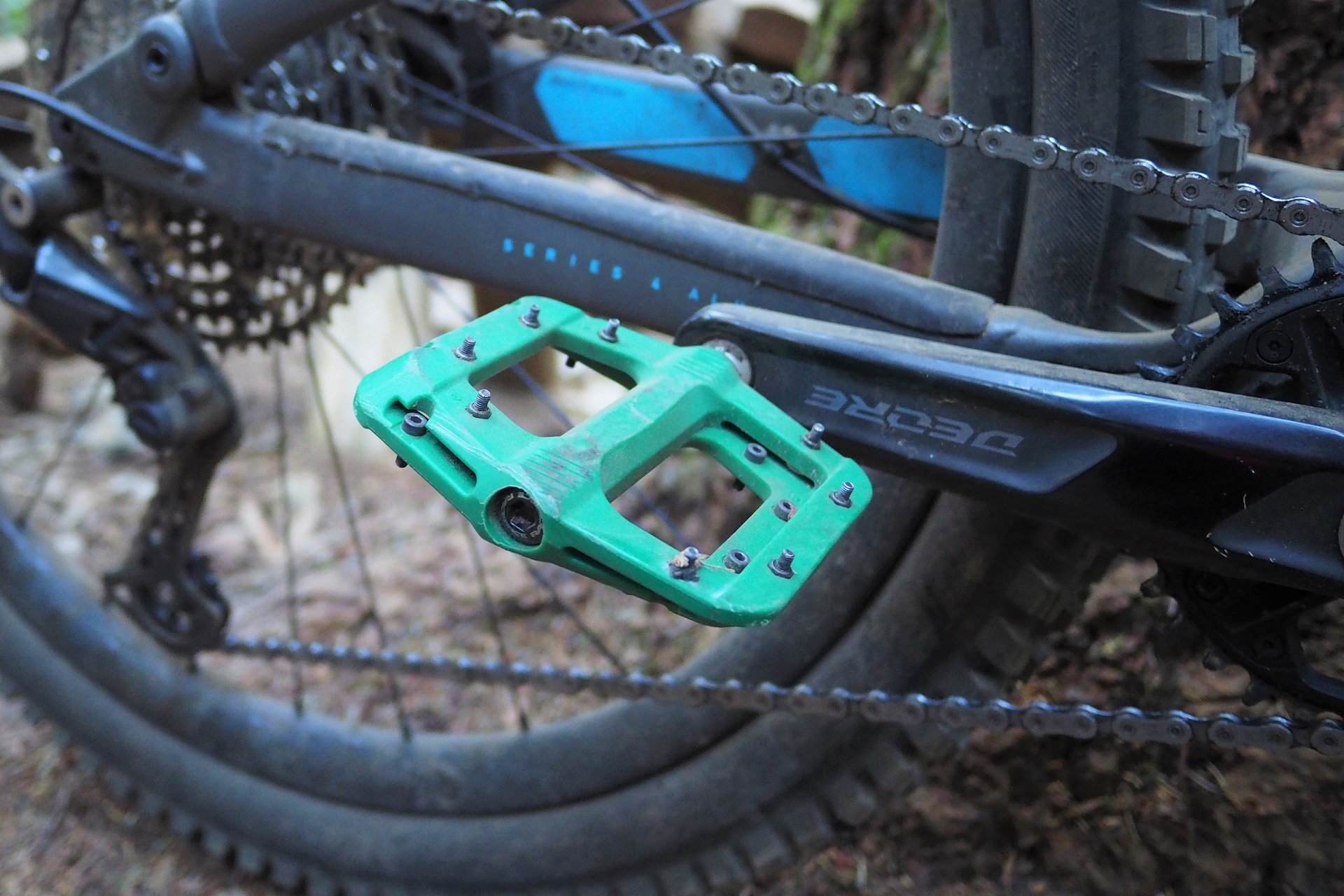
There are more budget-friendly options that spin smoothly and have good traction like the Race Face Chester composites.

Or buy a pair of boutique machined beauties like these NSB Daemons, in silver for that timeless look, and just replace the internals as needed.
What makes a bicycle a mountain bike - a 'real' mountain bike for riding on trails? And I mean that practically. If you want to wax philosophical about the evolution of the Miyata 1000LT, Cooper would love to discuss it with you over here. At its most basic, a mountain bike is going to be optimized for trail use. Still too wishy-washy? In my mind a modern mountain bike should be fun for the average rider on a true-Blue rated trail.*
*I know, what's an average rider and trail ratings vary greatly from place to place.
Instead of worrying about nuances, let's at least agree that if a bicycle comes with 2.3”+ knobby tires, say Maxxis DHFs or similar, it’s intended primarily for off-road use. Where can you properly use a DHF-esque knobby tire with cheap traction-less plastic pedals without pins? Nowhere. So a bike that's coming with proper knobby tires, even if they're firmer rubber, should come with actual mountain bike-worthy pedals or, better yet, none at all. Let the owner decide if they want flats or clip-in pedals. Just in the world of flats they then have to choose aluminum or composite, convex or concave, and even large or small platform.
I’ll put it out there that good, resin, flat pedals with solid traction start at about 55-65 USD | 70-80 CAD for a pair of Race Face Chester, Kona Wah Wah 2, or OneUp composite pedals. Except to double that for similar quality bearings and pins on an aluminum body - which may be the right investment for someone that is going to service the internals through multiple sets of bearings. While there is a lot of crap out there, I think a good set of clip-in pedals starts with Shimano's M520* / ME700** depending on your preference for cage size. With cleats included, the M520 runs 50 USD | 65 CAD while the ME700 will set you back 65 USD | 85 CAD.
*In my experience, the upgraded guts of the M540 make it the best value in their lineup for a small-body clip-in pedal.
**ME700, also called simply 'Shimano Trail' is the replacement for the classic M530 trail pedal.
As has been true for higher-priced bikes for years now, I think a manufacturer would be silly to tie up spec dollars on a 1-2K bike with any of these options. Sure, I'm also the person that will argue that from mid-level and up, bikes shouldn't come with saddles or grips either, but I think it's much easier to make more universal choices with both those products than it is with pedals.
And maybe you're thinking that mountain bike for 1-2K should include rideable pedals? It's a lot of extra money - along with a helmet, shoes, etc - to pony up at purchase time. Manufacturers have purchasing power ubt what pedals should they spec? Flats or clip-ins? What size of platform? How many spec dollars should they commit to a quality option and what do they have to downgrade to get there? To reiterate, there are reasons that mid to high level mountain bikes don't include pedals anymore, and I think that should extend to any machine that's meant to be ridden off-road.
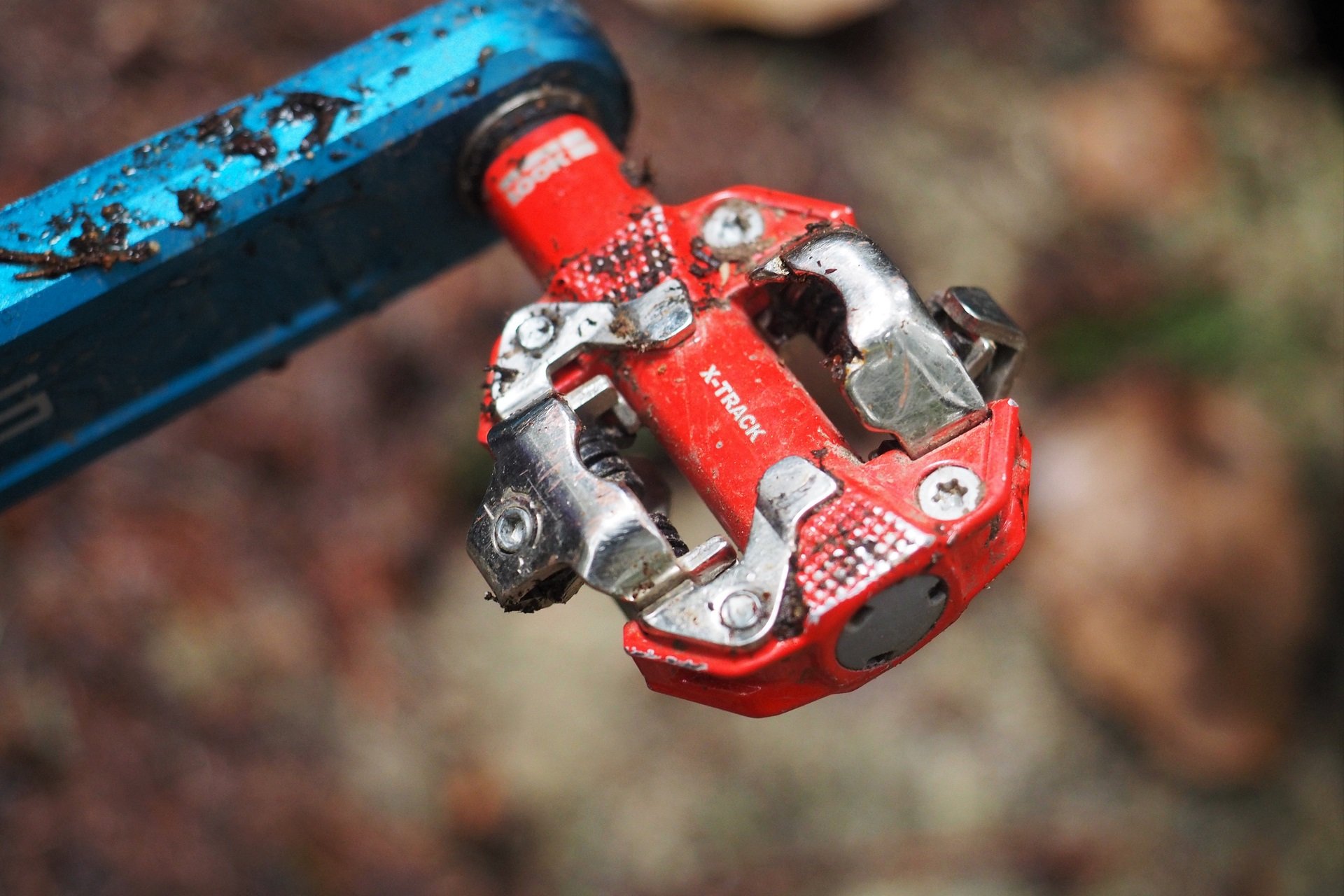
For a non-Shimano clip-in value option, I really enjoyed these SPD-compatible LOOK X-Track aluminum pedals at 55 USD | 75 CAD.
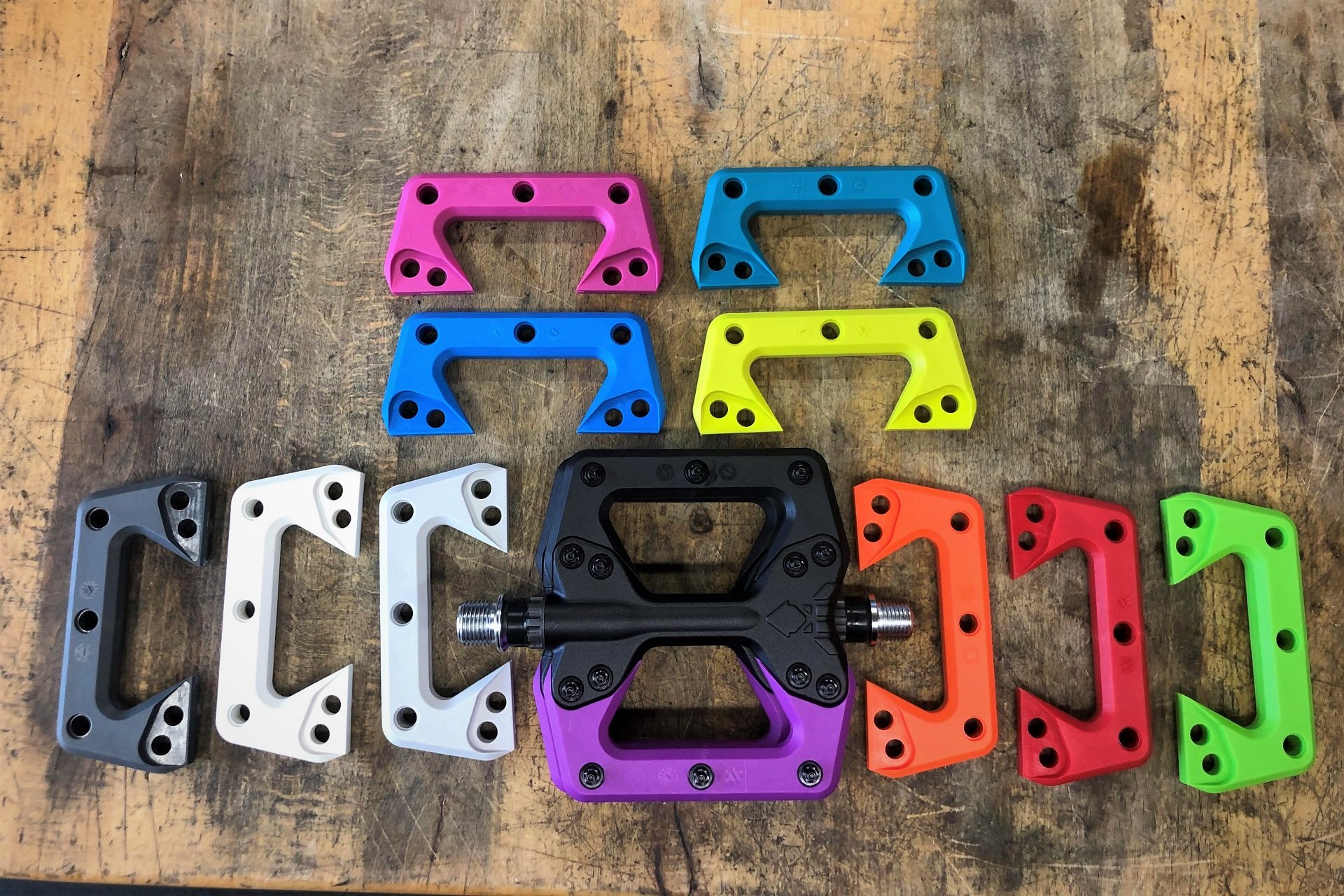
The point is, there are a lot of great options - like these modular Squidworx pedals - but what works for you is personal, and none of them are coming with your bike anyway.
Let's take a nominal 1,500 CAD hardtail with proper knobby tires and current mountain bike geometry. Let's take some basic plastic pedals with shitty loose ball bearings that feel seized out of the box and in-moulded pins that wouldn't stick to Gorilla Tape. Let's take a person buying that bike. There is absolutely no scenario where the combination of bike and pedals makes sense. Either the rider has been sold significantly more bike, with significantly more rubber, than they need for whatever their application may be or they're not experiencing even a small percentage of the capabilities of the machine. Either way that sucks for the manufacturer selling the rig, and it sucks for the rider buying it.
I'm passionate about budget mountain bikes, for actual mountain biking. I'd like to see manufacturers skipping the crappy plastic flats, and investing the couple of bucks they spend on them into other parts of the bicycles. Let shops educate customers on the best pedal options for them, the terrain they're riding, their experience level, their expectations, and their shoe size. And, when necessary, why junky OE pedals aren't included.
'Real' mountain bikes, at any price, don't come with pedals.
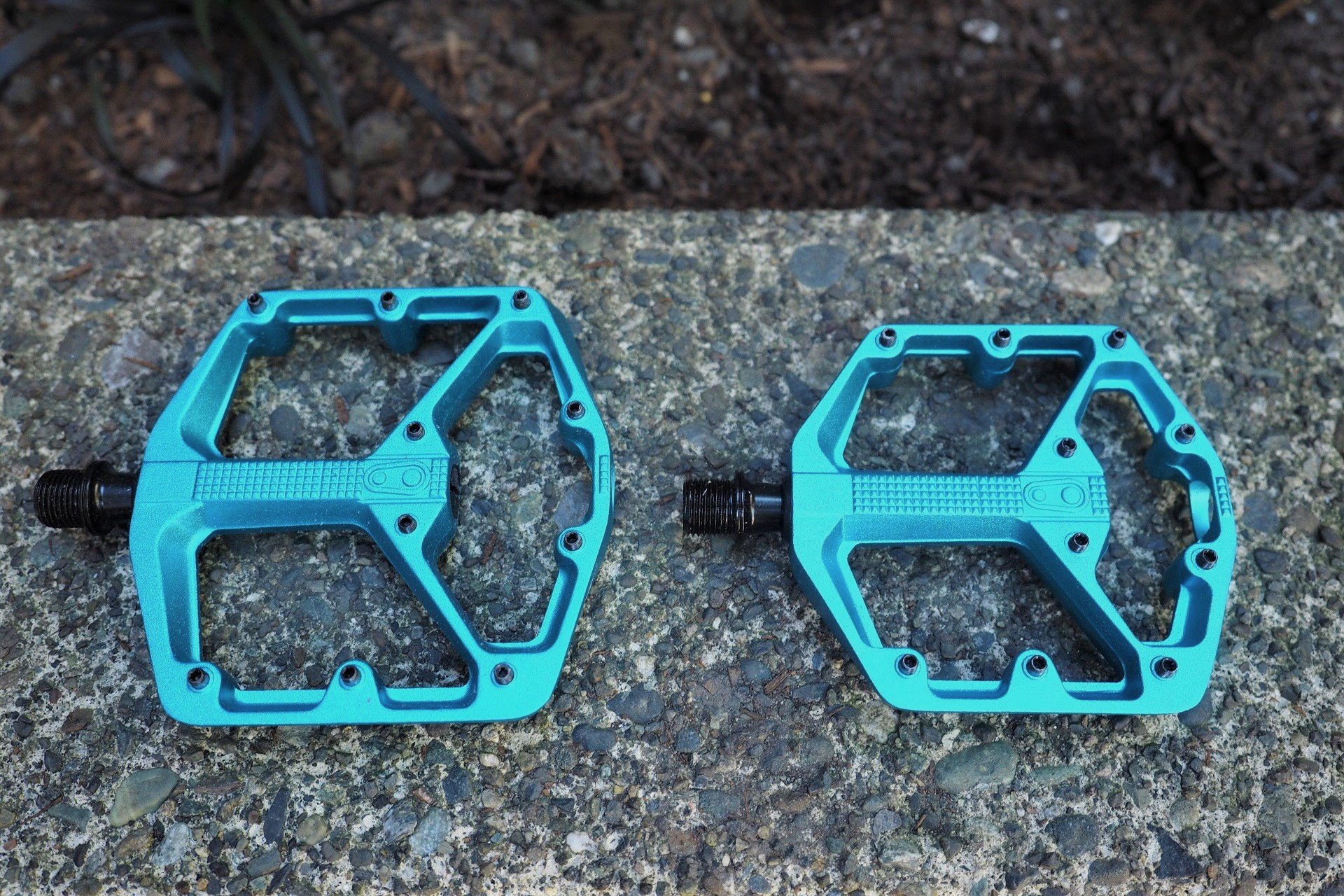
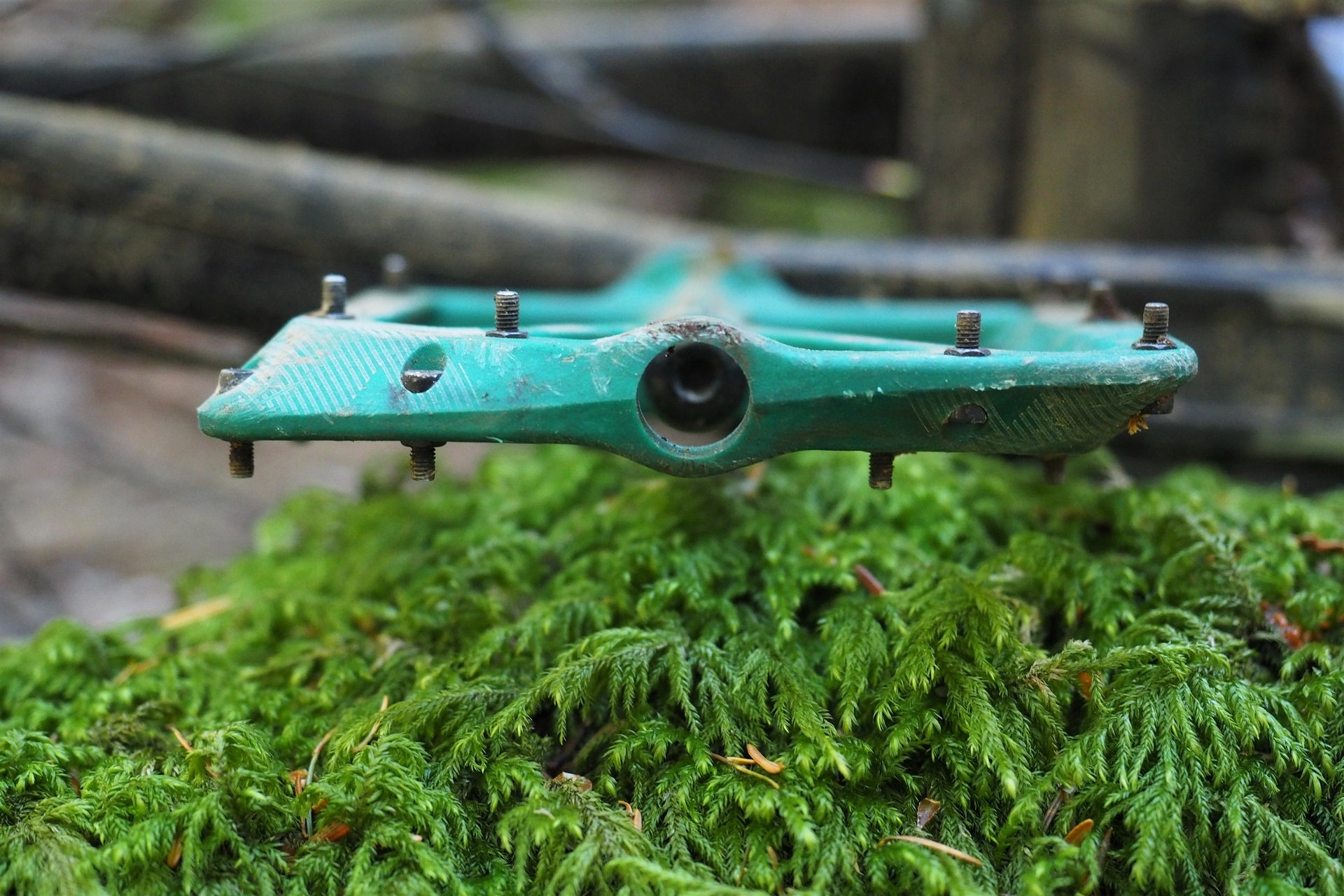


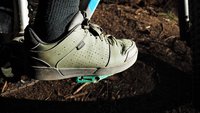








Comments
hambobet
1 year, 10 months ago
I assumed it was some sort of legal requirement - eg in the UK you have to sell a new bike with reflectors and a bell (maybe it's pedals too?)
Reply
fartymarty
1 year, 10 months ago
This is why a lot of bikes are sold in the UK without pedals - pedal reflectors are still a legal requirement. Where is if they are sold w/o pedals they can't be "ridden" therefore do not need to comply with the law. I think it is similar with front and rear reflectors.
It is a silly law give most people ride with lights that have similar power to car headlights.
OR - maybe if it is a legal requirement around the world - which it seems to be from reading some of the comments below then pedal manufacturers should design in reflectors.
AND - bikes should be sold with lights and a helmet as a legal requirement??? Or a helmet with lights built in...
Reply
Andrew Major
1 year, 10 months ago
The bell is an interesting one too. Many bikes come with bells (global spec) but many bikes also don’t. But bikes that come with pedals come with bells so I wonder if it’s as Marty says in terms of a complete bicycle.
It’s also been suggested to me that some companies make “included” pedals available upon request from a shop to save having to waste money/make waste. But I also couldn’t find any reference to it being a legal requirement that person-powered bikes ship with pedals.
Reply
fartymarty
1 year, 10 months ago
I have these https://www.knog.com/product/oi-classic-large/ on both bikes. They're quite useful and mount nicely by the stem. Walkers quite like that you give them some warning and are a lot more friendly when you do pass. I find the same when I'm walking the dogs - if someone on a bike rings their bell to give me some warning I will get out of the way and cheer them on.
Reply
Andrew Major
1 year, 10 months ago
I like to think that in the woods my friendly “hello” travels faster and farther than a bell (especially as I always slow for other users) but that could also be that I find the sound annoying when I’m hiking.
Slow down and say, “hi!”
I’m prepared for the idea I’m doing it wrong. I did have a bell in the cargo bike (pavement/light gravel commuting) but I gave it to a friend in a pinch and didn’t miss it at all.
Reply
Flatted-again
1 year, 10 months ago
I love the spurcycle bell I’ve got on my bike, but even though it’s very loud and I ding it like I’m blue oyster cult and someone’s got a fever, people still either ignore it or don’t register it until I’m right behind them. I do think it’s got something to do with local experience though- I grew up riding in an area where mini cowbells were available at the start of most trails (provided by local bike shops and trail orgs) and everyone knew the sound.
Reply
Vik Banerjee
1 year, 10 months ago
I'm a fan of talking to people if I need to pass them when I ride. I find bells pretty annoying and really you end up having to say something anyway as people do strange things once they know you are going to pass them.
Reply
Mark
1 year, 10 months ago
One of the worst things is wanting to pass a group or pair of hikers on a multi-use trail. You call out "On your left" or something similar and the group ubiquitously splits to either side of the trail with one of them moving right into your path and leaving just enough room to squeeze by while they gawk at you as some sort of alien.
BlazersDad89
1 year, 10 months ago
This comment has been removed.
Bikeryder85
1 year, 10 months ago
In the US it is a legal requirement, and if I am not mistaken they *have* to have reflectors. Even high end bikes had them at the shop I worked at years ago. If you replaced them at the point of sale (many did), we just put them in the bag with the manual (for liability).
*Edit*
This could have changed, as my experience *does not* make me an expert!
Reply
Andrew Major
1 year, 10 months ago
I’m not an expert on any jurisdiction’s safety legislation but I see enough bikes that ship without pedals with global spec that I don’t think that’s the case (or at least it’s not the case anymore, or maybe it’s the case they need reflectors if included in the USA).
*edit: if it was the case manufacturers would do well to just send a couple sets to each shop instead of creating the waste/wasting the money including them in the box. It’s been suggested to me that it is the law some places but manufacturers can get around it by only shipping them by request.
Reply
Timer
1 year, 10 months ago
These bad pedal specs make a lot of sense from a manufacturer perspective in many parts of the world. Around here (central europe), a large share of proper MTBs with big knobby tyres will never be ridden on what we call bike trails. They are bought for their looks or because most folks have no idea what kind of bike they need to ride on gravel paths. Shitty pedals are fine for those.
Its even worse with electric mopeds, where weight and rolling resistance doesn't matter at all and lots of people buy the most aggressive looking motorcycle for riding along pavement to the shops. Just like they do with cars.
Reply
Andrew Major
1 year, 10 months ago
Ugh. I’d argue still that anyone riding one of these bikes with the stock pedals either had been done a disservice in the pedals they’re on or, worse, the bike they’ve been sold.
At least swap the tires to something quieter and faster if traction isn’t an issue. But even then, a shop should have sold then a different rig than something with slow/loud 2.3”+ knobbies.
Reply
DMVancouver
1 year, 10 months ago
@Timer - that was my thought, too. I suspect a good proportion of $1500 mountain bikes will see only occasional use, never on dirt. Such a customer does not desire to have the knowledge that proper pedals are necessary, and least they will leave the shop with an operable bike.
Reply
Andrew Major
1 year, 10 months ago
I guess I operate in this imaginary world where riders are open minded about advice on the best bike for them and shop staff put in the effort to sell someone what they need.
But, anyone riding a knobby tired bike with pin-less moulded plastic pedals has been done, or done themselves, a disservice one way or the other.
There are some sweet, great fitting, hydraulic disc equipped, commuter rigs that are gravel friendly and will roll faster and smoother for less money.
Reply
Mark
1 year, 10 months ago
"...will roll faster and smoother for less money."
And cut it to the shop's profit margin?!? Never.
Reply
Brigham_Rupp
1 year, 10 months ago
I’m with you on the basic complaint; the throw-away pedals are silly. But it’s definitely an imaginary world your describing— especially one where most people purchase their bike at a shop with the help of a thoughtful expert. My claim would be that every “mountain bike” come with a set of cheap but usable pedals, and I would put that expectation on the brand claiming to sell “capable” mountain bikes. The last thing a kid buying his first bike wants is to find out that his new bike is fundamentally unrideable unless he drops another $100.
Reply
Andrew Major
1 year, 10 months ago
A good set of flat pedals purchased with a bike are going to be half that amount and a rideable pair of basic flats even less.
Aside from my contention that pedal choice is so broad that it’s best left to the point of sale, I do agree that on your example the best case would be for the bike company to spec good-enough flat pedals using their purchasing power. I’d even agree that below a certain price point (I don’t know what number that is) most people buying a mountain bike would be well served by having it include some good-enough flats. Maybe with size-specific platforms even.
But realistically, I think the most likely better-case scenario is the spec dollars being spent elsewhere and the shop discounting the right pedals at time of sale.
Reply
Andrew Major
1 year, 10 months ago
“But it’s definitely an imaginary world your describing— especially one where most people purchase their bike at a shop with the help of a thoughtful expert.”
How sad is that, if it’s the case? Good shops exist in every place I’d ridden a bike.
Whether it’s altruism or just maximizing the bottom line, I have a hard time imagining any decent shop selling mountain bikes with the stock pin-less pedals or even sending bikes out for test as such.
Performance aside, sticking a colourful range of moulded + pin pedals (OneUp, RaceFace, WahWah 2 in two sizes) is an easy way to make someone’s bike theirs.
Reply
Alex D
1 year, 10 months ago
It's not hard to find decent pedals for $10. CNC aluminum or nylon plastic body, screw-in metal spikes, steel spindle, sealed bearing and bushing configuration. Most of them come with excessively thick grease on the spindle, but otherwise, they're a strong facsimile of the $60+ boutique models. At OEM pricing, I'd expect the molded plastic dreck to run about $5 less. Not worth the savings, I would think.
Reply
Andrew Major
1 year, 10 months ago
Yeah, a “couple of bucks” as I said (received some different numbers from folks I asked). In the game of dollars and cents around budget rigs it’s not nothing (see example of better OE grips).
Not to mention the thousands upon thousands of cheap pedals it saves getting tossed (recycled or otherwise).
Reply
cheapondirt
1 year, 10 months ago
I agree, because to the person buying the entry level "real" MTB, they just spent a LOT of money. Being recommended to spend $65 more on a pair of pedals can feel like a total rip off to the newcomer.
I've been there twice, once in high school when my $950 hardtail cost half my life savings, and once fresh out of college, when I still had no business spending $1200. Both bikes got pedal upgrades pretty quick but just to whatever the most basic shelf model was. At that time all it took to please me was metal pins, and having to spend more to get them was salt in the wound - in the actual shin gouges.
My experience in both of those cases could have also been improved by someone simply setting my expectations.
Reply
Andrew Major
1 year, 10 months ago
I purposely avoided making a claim of the price where good-enough pedals start. Some basic Wellgo loose-ball flats with threaded pins are thick, crunchy, have small platforms, and will be short lived with real use but they’ll get the job done for plenty of folks plenty of places.
But yeah, I keep going back to the cheap pin-less plastic numbers vs. knobby tires and that person has the wrong pedals or the wrong bike 100%.
Reply
cheapondirt
1 year, 10 months ago
Absolutely right, those items should not be present together. If my tires need grip so do my feet.
Reply
kcy4130
1 year, 10 months ago
I agree, $10 wellgos would be far better. There's two types that buy entry level mtb: Mountain bikers on a budget, and new riders. A cheap but usable pedal will probably last long enough for a new rider to know if the sport is for them or not. An experienced biker, even one that changes pedals immediately can put the $10 wellgos on a kids bike or keep for spares. For $5 more you have a bike that can be ridden offroad vs one that can't, seems like a no brainer to me.
Reply
Andrew Major
1 year, 10 months ago
Even then, in many places a significant portion of $1000+ rigs are going the door with clip-in setups. I think the low waste, best case scenario is still to spend the couple-or-few pedal bucks on other upgrades and have the rider choose pedals at the point of sale.
Reply
kcy4130
1 year, 10 months ago
But point of sale means bike shop prices for pedals which goes back to the new rider possibly feeling like they're getting ripped off. For xc budget hardtails (i.e. nica specials) nearly all would go clipless, but for budget trail or all mountain bikes I'd think flats would be the vast majority.
Reply
Lu Kz
1 year, 10 months ago
A little while ago, for a brief time only, you could spec those garmin pedals on Trek's cross country bikes on the most baller of high end Project One bikes. You can't anymore. It looks like maybe it was too complicated and supply chains were rammed up or something. I was going to spec out a $17,000 AXS supercaliber with pedals as an absurd example of a "not real mountain bike" that came with pedals, but it looks like Trek doesn't want me to have fun anymore. Oh well.
Reply
Andrew Major
1 year, 10 months ago
“Could spec” being the key but I still would have handed you 10,000points for the effort (NSMB.com comment section points run on the ‘Whose Line’ model of course - meaningless, valueless, and arbitrary).
Reply
Carmel
1 year, 10 months ago
I guess that doesn't qualify as "budget" but my '14 Explosif came with aluminium cage style pedals (only suitable for city use) and a pair of Shimano M520 which are still in use. So not a total waste
Reply
Andrew Major
1 year, 10 months ago
May I ask where this was (in the world)? Not just something the shop rigged up? I sold Kona bikes many years ago (pre-2014) and they’d stopped shipping with clip-in pedals locally by then. My understanding is that was a global spec, but certainly I could be wrong.
Reply
Zero-cool
1 year, 10 months ago
I was told (bye a bike shop in the UK) several years ago that EU regulations meant that all bikes needed pedals and reflectors in the EU.
AND that the reason they were so cheap was that usually it was the retailer that had to stump up the coat for them and not the manufacturer.
Not sure if this is true but I’ve bought very few bikes that haven’t come with a bag of reflectors and pedals (rarely actually attached to the bike) and that includes both budget hardtails (jump bikes and Calibre) and expensive full suspension bikes (YT, Transition & Orange).
None of them have ever been ridden further than across the car park from shop to the van.
Reply
Andrew Major
1 year, 10 months ago
Not an expert on any jurisdictions laws re. bicycle safety but given the number of global-spec bicycles I see without pedals I don’t think that’s is the case - maybe it’s just if they do come with pedals they have to have reflectors?
(Hence most bikes that came with clip-in pedals had plastic platforms that popped in.)
*edit: bikes that are assembled in the box (not just frame and all the parts) always come with reflectors. I know this is to comply with US law but it could be other jurisdictions as well.
Reply
Andy Eunson
1 year, 10 months ago
Some people claim to prefer the plastic gripless pedals. I ride with a group of people mostly over 70. It’s a social ride. A lot of highly educated people. Mostly ebikes now. About half of them have proper shoes nd pedals but the other half "prefer" the plastic pedals because they are afraid of the steel pins. I’ve been telling them that with proper shoes, (not spd shoes with the cleat cover plate in place) and proper pedals you’ll have the grip that will allow you to stay on the pedals. Their fear overcomes their ability to reason. A few have changed over and they can’t believe the difference.
I don’t think any high end bike comes with pedals. Nor should they. I don’t think there is any legal requirement for a shop to install any reflectors on bikes they sell. I’ve never had them on any bike I’ve bought over the years. A lot of people buying low end bikes will ride pretty easy stuff or only on the road and the odd gravel path for commuting or the six rides a year that they do. For them the plastic pedals are acceptable. We enthusiast riders have a very different perspective. Back in the day, many people insisted on having Gumby levers installed on their low end road bikes. I had customers that rode in only one gear ever.
Reply
Andrew Major
1 year, 10 months ago
If they don’t need properly grippy pedals they don’t need massive grippy tires or other overbuilt MTB components. I think a rider with 2.3”+ knobbies and these pedals has the wrong rig or the wrong pedals. If your Dr Dew comes with pin-less plastic that’s cool.
I didn’t / don’t take e-bikes into consideration here. With a 4:1 Turbo setup any rider could spin Assegais with CushCore Pro on the local bike path sporting MKS Sylvan flats.
Also talking about 1K+ rigs not 10K+ rigs.
Reply
Alex D
1 year, 10 months ago
Not everyone has a natural feel for cycling. Like not stopping, putting a foot down, then accidentally backpedaling the other foot and driving the pedal into your shin. I wouldn't do that. You wouldn't do that. But a lot of people would, and they rightfully fear the result from a bunch of sharp pins.
Reply
Cam McRae
1 year, 10 months ago
Ask Joe Biden about toeclips!
Reply
Andrew Major
1 year, 10 months ago
I’d love to meet an experienced cyclist / mountain biker who hasn’t fallen over at some point because their clip-in pedal didn’t release as planned or, worse yet, they caught the edge pins of their pedal on the inside of their super-sticky-soled flat pedal shoe when they didn’t quite step off all the way.
I’d bet those manoeuvres have taken out more hangers and derailleurs than any combination of falling off skinnies or getting hung up or smoking them on tight trails.
Reply
Velocipedestrian
1 year, 10 months ago
I clearly remember a friend giving me good advice when I got my first set of clips.
"find a flat grass field, and practice stopping then unclipping. Anyone can unclip before braking, but you'll need to be able to do it after you've stopped for the hazard."
Did I take this advice? Hell to the no. I rode up Signal Hill, then toppled sideways into a gorse bush at 0km/hr like a real mountain biker.
Reply
Andrew Major
1 year, 10 months ago
Totally. And they don’t need super grippy pedals on their city bike.
But regardless of cycling experience/ ability I maintain that if your application requires grippy tires it also requires grippy pedals.
Even if there are exceptions to this, the universal spec of pin-less plastic pedals on budget mountain bikes is still wasteful at best both in terms of pedals being recycled and spec dollars that could have been spent otherwise. I think (wrong bike or wrong pedals) it also is indicative of folks not being sold their best possible riding experience.
Reply
Please log in to leave a comment.